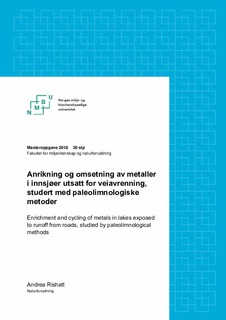| dc.contributor.advisor | Riise, Gunnhild | |
| dc.contributor.advisor | Rohrlack, Thomas | |
| dc.contributor.advisor | Haaland, Ståle | |
| dc.contributor.advisor | Meland, Søndre | |
| dc.contributor.author | Rishatt, Andrea | |
| dc.date.accessioned | 2018-09-27T10:56:27Z | |
| dc.date.available | 2018-09-27T10:56:27Z | |
| dc.date.issued | 2018 | |
| dc.identifier.uri | http://hdl.handle.net/11250/2564954 | |
| dc.description.abstract | Ved hjelp av paleolimnologiske metoder kan man undersøke metallkonsentrasjonene for de ulike lag i en sedimentsøyle og hvordan konsentrasjonene har endret seg over tid. En uforstyrret sedimentsøyle som går langt tilbake i tid, vil kunne gi viktig informasjon om metallkonsentrasjonene i nyere avsatte sedimenter har økt eller avtatt som følge av naturlige eller antropogene påvirkninger. I dette studiet har paleolimnologiske metoder blitt benyttet for å rekonstruere tidsutviklingen med hensyn på tungmetaller i Søndre Brutjern og Kutjern tilbake til perioden før veiavrenning. Sentralt i denne studien har vært å undersøke om veiavrenning fra den gamle E18 Riksgrensen-Ørje bidrar til økte konsentrasjoner av tungmetaller i innsjøene, og om veisalt har bidratt til sjiktning og anoksiske forhold i bunnvannet av innsjøene.
Det ble samlet inn en sedimentsøyle for hver innsjø i februar 2017, mens innsjøene var dekket med is. Sedimentsøylene ble datert ut fra innhold av radioaktivt cesium (Cs-137) og analysert for innhold av tungmetaller nikkel (Ni), kobber (Cu), krom (Cr), sink (Zn), kadmium (Cd) og bly (Pb), samt natrium (Na), svovel (S), mangan (Mn) og kalium (K), magnesium (Mg) aluminium (Al) og jern (Fe). Principal component analyse (PCA) for hver innsjø ble benyttet for å belyse variasjonen mellom de ulike variablene. Tungmetallkonsentrasjonene i de eldste sedimentene viste til dels små variasjoner fram til 1950-tallet, og kan anses som referansesedimenter. Blyinnholdet i begge innsjøene viste økning fra begynnelsen av 1950 og avtok kraftig etter 1990. Konsentrasjonsforløpet i innsjøene hadde sammenheng med økt bruk av blyholdig bensin fram til omkring 1990. Zn, Cd, Ni, Cr og Cu viste alle en generell økning fra omkring 1960, med unntak av Cd og Zn i Søndre Brutjern som økte fra midten av 1950-tallet.
Denne studien viser at atmosfæriske antropogene avsetninger av svovel (sur nedbør) i kombinasjon med veiavrenning sannsynligvis er viktige faktorer for de økte konsentrasjoner av tungmetaller i Søndre Brutjern og Kutjern siden 1960. Videre viser studien at innsjøene med stor sannsynlighet er kjemisk sjiktet og anoksisk i bunnvannet i februar antakelig på grunn av avrenning av veisalt fra E18. Metallkonsentrasjonene i innsjøene vurderes til å ha økt med tiden trolig som følge av veiavrenning, og nylig avsatt sedimenter har høyere metallkonsentrasjoner enn referansesedimenter. | nb_NO |
| dc.description.abstract | Paleolimnological methods can be used to investigate the concentration of metals in the different layers of a sediment column, and they can show how the concentrations have changed over time. A deep, undisturbed sediment column, which gives an extended, historic account of the soil, can show whether the metal concentrations in recent deposited sediments have increased or decreased due to natural influences or, conversely, due to anthropogenic ones. In this study, paleolimnological methods are used to reconstruct the time evolution of heavy metals in Søndre Brutjern and Kutjern, extending back to the period before runoff from road. Central to this study has been the investigation into whether runoff from the old road E18 Riksgrensen-Ørje contributes to increased concentrations of heavy metals in lakes. This study also shows the level to which road salt has contributed to a chemical layer and anaerobic conditions in the bottom water of those lakes.
Sediment samples from both lakes were collected in February 2017, while the lakes still were covered in ice. The sediment columns from Søndre Brutjern and Kutjern were analyzed for radioactive cesium (Cs-137), heavy metals nickel (Ni), copper (Cu), chromium (Cr), zinc (Zn), cadmium (Cd) and lead (Pb) as well as sodium (Na), manganese (Mn), potassium (K), magnesium (Mg), aluminum (Al) and iron (Fe). Principal component analysis (PCA) for each lake was used to illustrate the variations between the different samples. Heavy metal concentrations in the oldest sediments show small variations up to the 1950s and can be regarded as reference sediments. The content of lead in both lakes increased in the beginning of the 1950’s and declined sharply after the 1990’s. The concentration in the lakes is associated with increased use of leaded petrol. Levels of Zn, Cd, Ni, Cr and Cu show a general increase starting around 1960, with the exception of Cd and Zn in Søndre Brutjern, which started to increase in the mid-1950s. This study shows that atmospheric anthropogenic sulfur (acid rain), in combination with runoff from roads, are important factors in the increased concentrations of heavy metals found at Søndre Brutjern and Kutjern since 1960. Furthermore, the study shows that the lakes are more likely to have a chemically layer and be anoxic in the bottom water in February, probably due to the runoff of road salt from the E18. The concentration of metals in the lakes is estimated to have increased over time due to runoff from the road; therefore, recently deposited sediments have higher metal concentrations than the reference sediments. | nb_NO |
| dc.language.iso | nob | nb_NO |
| dc.publisher | Norwegian University of Life Sciences, Ås | nb_NO |
| dc.rights | Attribution-NonCommercial-NoDerivatives 4.0 Internasjonal | * |
| dc.rights.uri | http://creativecommons.org/licenses/by-nc-nd/4.0/deed.no | * |
| dc.title | Anrikning og omsetning av metaller i innsjøer utsatt for veiavrenning, studert med paleolimnologiske metoder | nb_NO |
| dc.title.alternative | Enrichment and cycling of metals in lakes exposed to runoff from roads, studied by paleolimnological methods | nb_NO |
| dc.type | Master thesis | nb_NO |
| dc.description.version | submittedVersion | nb_NO |
| dc.description.localcode | M-NF | nb_NO |

